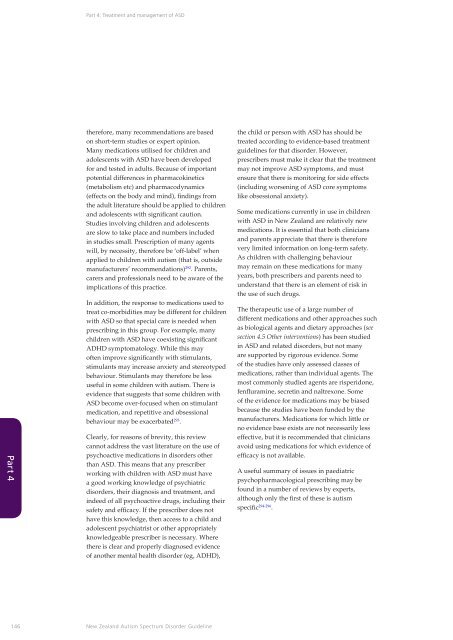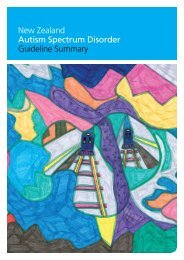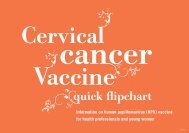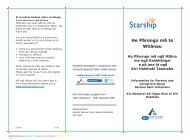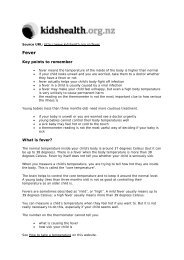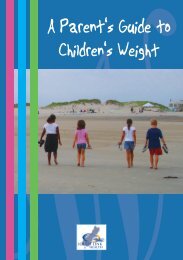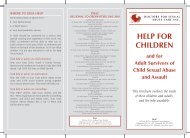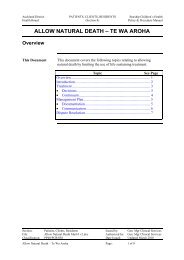New Zealand Autism Spectrum Disorder Guideline - Ministry of Health
New Zealand Autism Spectrum Disorder Guideline - Ministry of Health
New Zealand Autism Spectrum Disorder Guideline - Ministry of Health
Create successful ePaper yourself
Turn your PDF publications into a flip-book with our unique Google optimized e-Paper software.
Part 4: Treatment and management <strong>of</strong> ASD<br />
Part 4<br />
therefore, many recommendations are based<br />
on short-term studies or expert opinion.<br />
Many medications utilised for children and<br />
adolescents with ASD have been developed<br />
for and tested in adults. Because <strong>of</strong> important<br />
potential differences in pharmacokinetics<br />
(metabolism etc) and pharmacodynamics<br />
(effects on the body and mind), findings from<br />
the adult literature should be applied to children<br />
and adolescents with significant caution.<br />
Studies involving children and adolescents<br />
are slow to take place and numbers included<br />
in studies small. Prescription <strong>of</strong> many agents<br />
will, by necessity, therefore be ‘<strong>of</strong>f-label’ when<br />
applied to children with autism (that is, outside<br />
manufacturers’ recommendations) 292 . Parents,<br />
carers and pr<strong>of</strong>essionals need to be aware <strong>of</strong> the<br />
implications <strong>of</strong> this practice.<br />
In addition, the response to medications used to<br />
treat co-morbidities may be different for children<br />
with ASD so that special care is needed when<br />
prescribing in this group. For example, many<br />
children with ASD have coexisting significant<br />
ADHD symptomatology. While this may<br />
<strong>of</strong>ten improve significantly with stimulants,<br />
stimulants may increase anxiety and stereotyped<br />
behaviour. Stimulants may therefore be less<br />
useful in some children with autism. There is<br />
evidence that suggests that some children with<br />
ASD become over-focused when on stimulant<br />
medication, and repetitive and obsessional<br />
behaviour may be exacerbated 293 .<br />
Clearly, for reasons <strong>of</strong> brevity, this review<br />
cannot address the vast literature on the use <strong>of</strong><br />
psychoactive medications in disorders other<br />
than ASD. This means that any prescriber<br />
working with children with ASD must have<br />
a good working knowledge <strong>of</strong> psychiatric<br />
disorders, their diagnosis and treatment, and<br />
indeed <strong>of</strong> all psychoactive drugs, including their<br />
safety and efficacy. If the prescriber does not<br />
have this knowledge, then access to a child and<br />
adolescent psychiatrist or other appropriately<br />
knowledgeable prescriber is necessary. Where<br />
there is clear and properly diagnosed evidence<br />
<strong>of</strong> another mental health disorder (eg, ADHD),<br />
the child or person with ASD has should be<br />
treated according to evidence-based treatment<br />
guidelines for that disorder. However,<br />
prescribers must make it clear that the treatment<br />
may not improve ASD symptoms, and must<br />
ensure that there is monitoring for side effects<br />
(including worsening <strong>of</strong> ASD core symptoms<br />
like obsessional anxiety).<br />
Some medications currently in use in children<br />
with ASD in <strong>New</strong> <strong>Zealand</strong> are relatively new<br />
medications. It is essential that both clinicians<br />
and parents appreciate that there is therefore<br />
very limited information on long-term safety.<br />
As children with challenging behaviour<br />
may remain on these medications for many<br />
years, both prescribers and parents need to<br />
understand that there is an element <strong>of</strong> risk in<br />
the use <strong>of</strong> such drugs.<br />
The therapeutic use <strong>of</strong> a large number <strong>of</strong><br />
different medications and other approaches such<br />
as biological agents and dietary approaches (see<br />
section 4.5 Other interventions) has been studied<br />
in ASD and related disorders, but not many<br />
are supported by rigorous evidence. Some<br />
<strong>of</strong> the studies have only assessed classes <strong>of</strong><br />
medications, rather than individual agents. The<br />
most commonly studied agents are risperidone,<br />
fenfluramine, secretin and naltrexone. Some<br />
<strong>of</strong> the evidence for medications may be biased<br />
because the studies have been funded by the<br />
manufacturers. Medications for which little or<br />
no evidence base exists are not necessarily less<br />
effective, but it is recommended that clinicians<br />
avoid using medications for which evidence <strong>of</strong><br />
efficacy is not available.<br />
A useful summary <strong>of</strong> issues in paediatric<br />
psychopharmacological prescribing may be<br />
found in a number <strong>of</strong> reviews by experts,<br />
although only the first <strong>of</strong> these is autism<br />
specific 294-296 .<br />
146<br />
<strong>New</strong> <strong>Zealand</strong> <strong>Autism</strong> <strong>Spectrum</strong> <strong>Disorder</strong> <strong>Guideline</strong>


